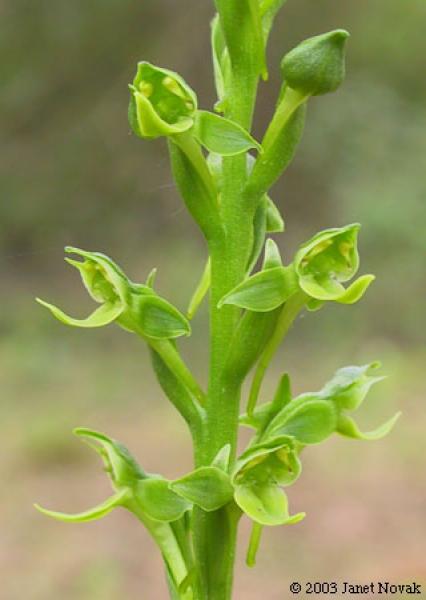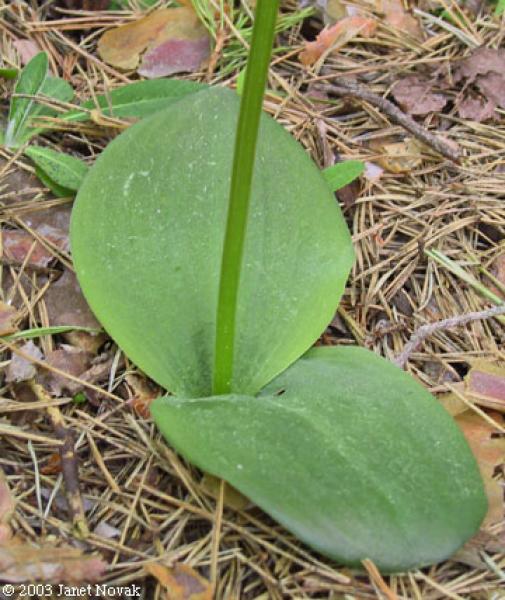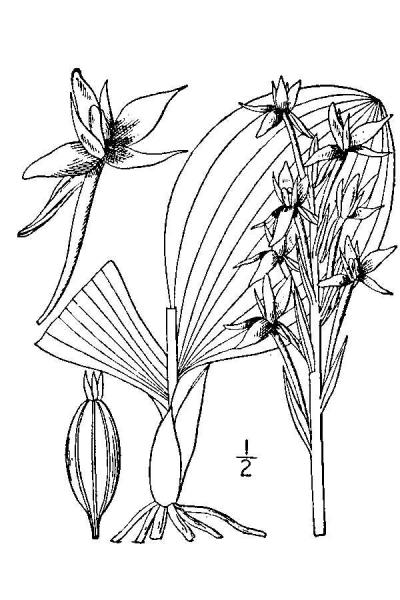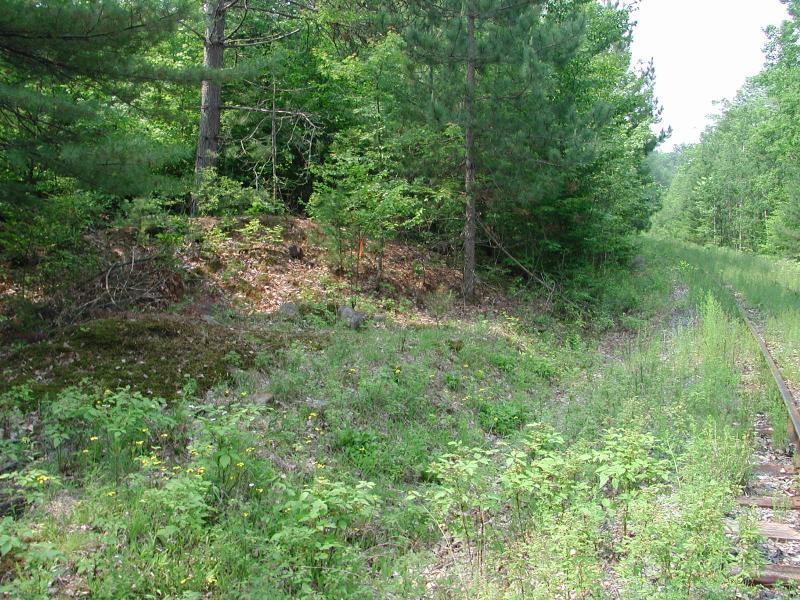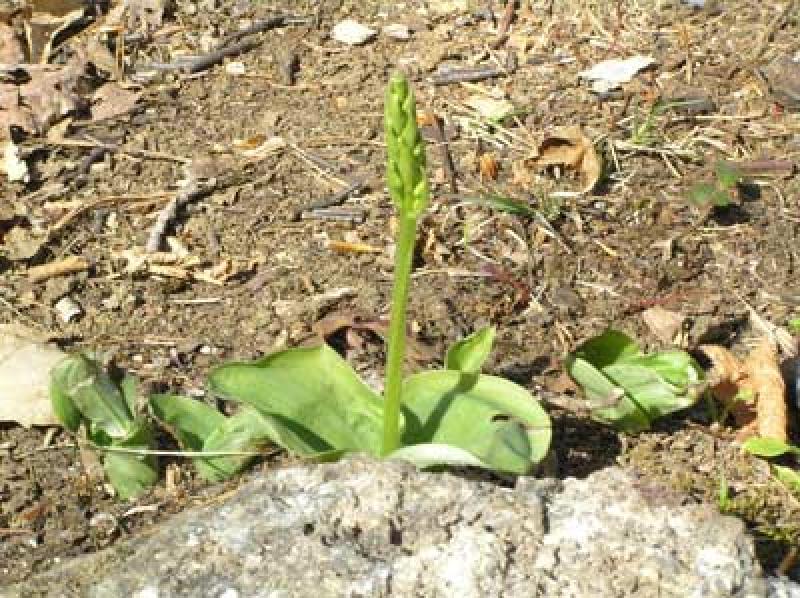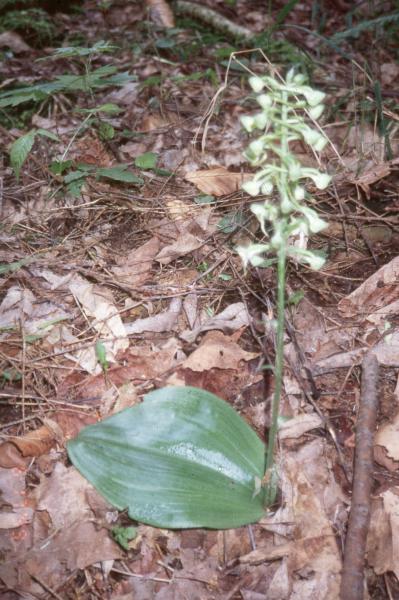Hooker's Orchid
Platanthera hookeri (Torr. ex Gray) Lindl.
- Class
- Monocotyledoneae (Monocots)
- Family
- Orchidaceae (Orchid Family)
- State Protection
- Endangered
Listed as Endangered by New York State: in imminent danger of extirpation in New York. For animals, taking, importation, transportation, or possession is prohibited, except under license or permit. For plants, removal or damage without the consent of the landowner is prohibited.
- Federal Protection
- Not Listed
- State Conservation Status Rank
- S1
Critically Imperiled in New York - Especially vulnerable to disappearing from New York due to extreme rarity or other factors; typically 5 or fewer populations or locations in New York, very few individuals, very restricted range, very few remaining acres (or miles of stream), and/or very steep declines.
- Global Conservation Status Rank
- G4
Apparently Secure globally - Uncommon in the world but not rare; usually widespread, but may be rare in some parts of its range; possibly some cause for long-term concern due to declines or other factors.
Summary
Did you know?
Similar to Platanthera orbiculata and Platanthera macrophylla, Platanthera hookeri has a pair of large rounded leaves that lie flat against the ground. In 19th-century Vermont the leaves were applied as a plaster to heal weak lungs, and to heal bruises and reduce soreness. The species was named by 19th-century English botanist John Lindley for his colleague Sir William Jackson Hooker, director of Kew Gardens in London. Lindley was instrumental in saving the garden from destruction in the 1830s.
State Ranking Justification
There are four known populations. Two additional populations have been reported in the last 20 years that recent surveys have failed to relocate. Populations of this plant have declined sharply over the past 100 years. The reasons for this are unknown, but acid rain has been speculated as a likely cause.
Short-term Trends
Populations have persisted at very low levels over the past ten years. No more than five populations were known at any one time and now only two populations are known. This trend of small fluctuating numbers will probably continue into the foreseeable future.
Long-term Trends
There has been a large decline in populations of this orchid especially since the beginning of the 1950s. In the first half of the 20th century, 36 new locations were found for this orchid but only 11 in the second half of the century and none since the year 2000. Five populations were known in the 1970s but only three new populations were discovered since then and only two are still surviving today. From these data we can imagine that this orchid was not an uncommon sight in our forests before the 1950s but now it is almost gone.
Conservation and Management
Threats
The real reasons for the decline of this orchid are unknown. Substantial habitat remains throughout the state but past land management practices, habitat destruction, and other factors such as the increase in the deer herd, climate change, and pollution have all been suggested. More detailed research into its decline is needed.
Conservation Strategies and Management Practices
Once more is known about the direct threats to these plants, appropriate management can be undertaken. With so few populations known today and the sharp decline observed over the past 100 years, frequent monitoring should take place to better understand the dynamics influencing these populations.
Research Needs
Research needs to be undertaken to discover why this plant is in severe decline throughout the state. More detailed studies on the demography of the species should also be done to understand the factors that influence its appearance each year.
Habitat
Habitat
This orchid is found in dry to moist woodlands and forest, but seems to prefer more forested areas with open understories or successional forest, particularly those dominated by poplar and pine (New York Natural Heritage Program 2005). Dry to mesic coniferous and deciduous forest (Flora of North America 2002). Rare in rich, well-drained deciduous woods (Rhoads and Block 2000). Rich moist woods (Gleason and Cronquist 1991, as Habenaria hookeri). Coniferous or mixed woods, thickets, and borders, especially on wooded dunes and sandy soil near the Great Lakes; less often in deciduous forest or hemlock-hardwoods (Voss 1972, as Habenaria hookeri). Dryish woods (Fernald 1970, as Habenaria hookeri).
Associated Ecological Communities
- Appalachian oak-hickory forest*
(guide)
A hardwood forest that occurs on well-drained sites, usually on ridgetops, upper slopes, or south- and west-facing slopes. The soils are usually loams or sandy loams. This is a broadly defined forest community with several regional and edaphic variants. The dominant trees include red oak, white oak, and/or black oak. Mixed with the oaks, usually at lower densities, are pignut, shagbark, and/or sweet pignut hickory.
- Appalachian oak-pine forest*
(guide)
A mixed forest that occurs on sandy soils, sandy ravines in pine barrens, or on slopes with rocky soils that are well-drained. The canopy is dominated by a mixture of oaks and pines.
- Beech-maple mesic forest
(guide)
A hardwood forest with sugar maple and American beech codominant. This is a broadly defined community type with several variants. These forests occur on moist, well-drained, usually acid soils. Common associates are yellow birch, white ash, hop hornbeam, and red maple.
- Calcareous talus slope woodland*
(guide)
An open or closed canopy community that occurs on talus slopes composed of calcareous bedrock such as limestone or dolomite. The soils are usually moist and loamy; there may be numerous rock outcrops.
- Chestnut oak forest
(guide)
A hardwood forest that occurs on well-drained sites in glaciated portions of the Appalachians, and on the coastal plain. This forest is similar to the Allegheny oak forest; it is distinguished by fewer canopy dominants and a less diverse shrublayer and groundlayer flora. Dominant trees are typically chestnut oak and red oak.
- Hemlock-northern hardwood forest
(guide)
A mixed forest that typically occurs on middle to lower slopes of ravines, on cool, mid-elevation slopes, and on moist, well-drained sites at the margins of swamps. Eastern hemlock is present and is often the most abundant tree in the forest.
- Limestone woodland*
(guide)
A woodland that occurs on shallow soils over limestone bedrock in non-alvar settings, and usually includes numerous rock outcrops. There are usually several codominant trees, although one species may become dominant in any one stand.
- Pine-northern hardwood forest*
(guide)
A mixed forest that occurs on gravelly outwash plains, delta sands, eskers, and dry lake sands in the Adirondacks. The dominant trees are white pine and red pine.
- Red maple-hardwood swamp
(guide)
A hardwood swamp that occurs in poorly drained depressions, usually on inorganic soils. Red maple is usually the most abundant canopy tree, but it can also be codominant with white, green, or black ash; white or slippery elm; yellow birch; and swamp white oak.
- Successional northern hardwoods
A hardwood or mixed forest that occurs on sites that have been cleared or otherwise disturbed. Canopy trees are usually relatively young in age (25-50 years old) and signs of earlier forest disturbance are often evident. Characteristic trees and shrubs include any of the following: quaking aspen, big-tooth aspen, balsam poplar, paper birch, gray birch, pin cherry, black cherry, red maple, and white pine.
* probable association but not confirmed.
Associated Species
- Carpinus caroliniana
- Cypripedium acaule (pink lady's-slipper)
- Epigaea repens (trailing-arbutus, mayflower)
- Fagus grandifolia (American beech)
- Hamamelis virginiana (witch-hazel)
- Leucobryum glaucum
- Maianthemum canadense (Canada mayflower)
- Polygala paucifolia
- Populus deltoides
- Prenanthes trifoliolata
- Tsuga canadensis (eastern hemlock)
- Vaccinium pallidum (hillside blueberry)
- Viburnum acerifolium (maple-leaved viburnum)
Range
New York State Distribution
Historically this orchid was reported throughout much of New York, ranging from the Hudson Valley and Adirondack foothills, west through central and western New York. Today it is only known from a few populations near Ithaca and the eastern Adirondack foothills.
Global Distribution
A plant ranging from Newfoundland and Nova Scotia, south to New Jersey and Pennsylvania, and west to Manitoba, Minnesota, and Iowa.
Identification Comments
General Description
Hooker's orchid grows up to 10 inches tall from two broadly rounded to widely oblong, thick, green leaves up to 6 inches long that lie flat on the ground. The green flowering stem has no leaves and is topped by an unbranched inflorescence of 10-15 yellowish-green flowers on flower stalks that arise at an upward angle from the stem. The flowers are only about 3/4 inch wide with a tongue-shaped lip that curls up at the end and a long spur that angles down at the back.
Identifying Characteristics
The leaves of this orchid are orbicular, broadly elliptic or oblong-obovate, lay flat on the ground, thick, 5-16 cm long, and 2.5-12 cm broad. The scape is fleshy, naked, and 7-25 cm high. The flowers are greenish or greenish-yellow, sessile in a strict spike 5-25 cm long, and 2-4 cm wide. The upper lance-acuminate sepal is 7-11 mm long and the lateral sepals are 8.5-11.5 mm long. The petals are 6-9 mm long. The lip is 9-13 mm long and the spur is 1.4-2.5 cm long.
Best Life Stage for Proper Identification
This orchid often does not flower, and identification based solely on the leaves is difficult. Plants with a flowering stalk are easiest to identify.
Similar Species
Platanthera orbiculata has a scape with a few leafy bracts present and basal leaves that may reach up to 21 cm long. Its white or greenish-white flowers tend to appear later than Platanthera hookeri. Platanthera macrophylla is also bigger with very thin leaves up to 24 cm. The flowers are usually whiter than Platanthera orbiculata and with a very long spur 2.9-4.5 cm long. These two orchids bloom about 2-3 weeks later than Platanthera hookeri.
Best Time to See
Depending where in the state you look, flowers may be observed sometime between mid-May to early August. The peak flowering period appears to be late June to early July. While plants often do not flower, surveys should nonetheless be conducted during the peak blooming period. Vegetative plants are more difficult to locate and identify.
- Vegetative
- Flowering
- Fruiting
The time of year you would expect to find Hooker's Orchid vegetative, flowering, and fruiting in New York.
Hooker's Orchid Images
Images of Similar Species
Taxonomy
Hooker's Orchid
Platanthera hookeri (Torr. ex Gray) Lindl.
- Kingdom Plantae
- Phylum Anthophyta
- Class Monocotyledoneae
(Monocots)
- Order Orchidales
- Family Orchidaceae (Orchid Family)
- Order Orchidales
- Class Monocotyledoneae
(Monocots)
- Phylum Anthophyta
Additional Common Names
- Pad-leaf
Synonyms
- Habenaria hookeri Torr. ex Gray [Name used by Fernald (1970), Voss (1972), and Gleason and Cronquist (1991).]
- Lysias hookeri (Torrey ex A. Gray) Rydb. ex Britt.
- Lysias hookeriana auct. non [A typographic variant that appears in older reports.]
Additional Resources
Best Identification Reference
Gleason, Henry A. and A. Cronquist. 1991. Manual of Vascular Plants of Northeastern United States and Adjacent Canada. The New York Botanical Garden, Bronx, New York. 910 pp.
Other References
Fernald, M.L. 1950. Gray's manual of botany. 8th edition. D. Van Nostrand, New York. 1632 pp.
Flora of North America Editorial Committee. 2002. Flora of North America, North of Mexico. Volume 26. Magnoliophyta: Liliidae: Liliales and Orchidales. Oxford University Press, New York. 723 pp.
Holmgren, Noel. 1998. The Illustrated Companion to Gleason and Cronquist's Manual. Illustrations of the Vascular Plants of Northeastern United States and Adjacent Canada. The New York Botanical Garden, Bronx, New York.
Mitchell, Richard S. and Gordon C. Tucker. 1997. Revised Checklist of New York State Plants. Contributions to a Flora of New York State. Checklist IV. Bulletin No. 490. New York State Museum. Albany, NY. 400 pp.
New York Natural Heritage Program. 2010. Biotics database. New York Natural Heritage Program. New York State Department of Environmental Conservation. Albany, NY.
New York Natural Heritage Program. 2024. New York Natural Heritage Program Databases. Albany, NY.
Reschke, Carol. 1990. Ecological communities of New York State. New York Natural Heritage Program, New York State Department of Environmental Conservation. Latham, NY. 96 pp. plus xi.
Rhoads, Ann F. and Timothy A. Block. 2000. The Plants of Pennsylvania, an Illustrated Manual. University of Pennsylvania Press, Philadelphia, PA.
Voss, E.G. 1972. Michigan Flora, Part I. Gymnosperms and Monocots. Cranbrook Institute of Science Bulletin 55 and the University of Michigan Herbarium. Ann Arbor. 488 pp.
Weldy, T. and D. Werier. 2010. New York flora atlas. [S.M. Landry, K.N. Campbell, and L.D. Mabe (original application development), Florida Center for Community Design and Research http://www.fccdr.usf.edu/. University of South Florida http://www.usf.edu/]. New York Flora Association http://newyork.plantatlas.usf.edu/, Albany, New York
Links
About This Guide
Information for this guide was last updated on: August 28, 2019
Please cite this page as:
New York Natural Heritage Program. 2024.
Online Conservation Guide for
Platanthera hookeri.
Available from: https://guides.nynhp.org/hookers-orchid/.
Accessed July 26, 2024.

